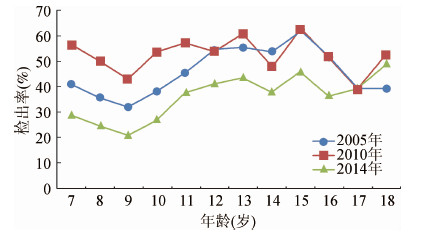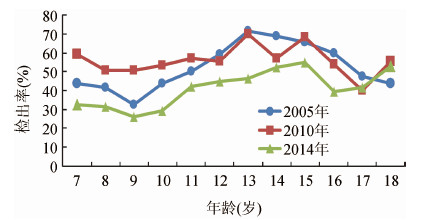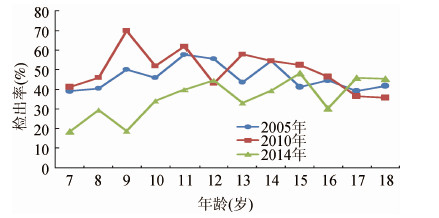文章信息
- 杨云娟, 常利涛, 陈露, 魏熙晶.2015.
- Yang Yunjuan, Chang Litao, Chen Lu, Wei Xijing.2015.
- 云南省临沧市2005-2014年佤族儿童青少年营养不良情况分析
- Study on malnutrition status among Wa ethnicity children and adolescents in Lingcang prefecture, Yunnan province
- 中华流行病学杂志, 2015, 36(12): 1391-1393
- Chinese Journal of Epidemiology, 2015, 36(12): 1391-1393
- http://dx.doi.org/10.3760/cma.j.issn.0254-6450.2015.12.016
-
文章历史
- 投稿日期: 2015-04-13
2. 云南省教育厅体育卫生与艺术处
2. Department of Sports Health and Art in Bureau of Education, Yunnan Province
为了改善和提高佤族儿童的生长发育水平和营养状况,云南省政府于2010年制定并实施《云南省学生营养系统工程项目规划(2010年-2020年)》,初步开展了“大豆行动”、“学生奶计划”、“鸡蛋工程”、“学生营养午餐”和农村寄宿制中小学营养工程等措施。2011年中央财政以补助学校营养午餐的方式提高贫困地区农村学生的健康水平[1]。为了解佤族儿童青少年目前的营养不良情况,本研究分析2005-2014年佤族7~18岁中小学生营养不良检出情况及其变化趋势,为今后调整佤族的营养改善实施方案提供参考依据。
对象与方法1. 研究对象:7~18岁佤族中小学生资料来自2005-2014年全国学生体质健康调研(少数民族部分)数据[2, 3]。合计有效人数为2005年2 638名(男生1 320名,女生1 318名),2010年2 628名(男生1 314名,女生1 314名),2014年2 644名(男生1 325名,女生1 319名)。
2. 研究方法:按照2014年全国学生体质健康调研标准的要求[4],由经过培训的专业人员测量身高和体重。使用身高坐高计和杠杆称测量受试者赤足身高(精确至0.1 cm)和体重(受试者穿短衣裤,赤足;精确至0.1 kg)。
3. 判断标准:利用身高和体重测量值计算BMI。依据WHO-2006标准进行儿童青少年营养不良筛查[5, 6]。营养不良包括生长迟滞和消瘦。性别、年龄别身高小于界值点记为生长迟缓(长期营养不良),性别、年龄别BMI小于界值点记为消瘦(即时性营养不良)。
4. 统计学分析:数据录入采用EpiData软件,统计学分析采用SPSS 17.0软件。主要采用描述性分析。
结 果1. 一般情况: 2005、2010和2014年分别调查2 638、2 628和2 644名学生。其中,2005年调查男生1 320名,女生1 318名;2010年调查男生1 314名,女生1 314名;2014年调查男生1 325名、女生1 319名。
2. 体格生长发育情况:从横断面资料看,2005-2010年5年间佤族男女生身高发育的突增年龄分别为14岁和10岁,至2014年男女生的突增年龄提前为13岁和9岁。2000年佤族男生身高突增最大值为7.17 cm,女生为6.44 cm;2014年男女生身高突增最大值分别为7.46和7.43 cm。2014年男女生的7岁身高增加明显。2014年与2005年相比,18岁男生平均身高下降1.31 cm,女生平均身高下降0.70 cm。2005、2010和2014年佤族18岁身高性别差分别为11.99、9.34和11.38 cm。9年间佤族儿童青少年的BMI值略有上升。
3. 单一生长迟滞检出情况:2005年7~18岁男、女生单一生长迟滞率为45.61%和42.03%,2010年为52.36%和47.41%,2014年为35.85%和33.06%(图1、2)。

|
| 图 1 2005、2010和2014年云南省临沧市7~18岁佤族男生 单一生长迟滞检出情况 |

|
| 图 2 2005、2010和2014年云南省临沧市7~18岁佤族女生 单一生长迟滞检出情况 |
4. 单一消瘦检出情况:2005年7~18岁男女生单一消瘦率为1.44%和0. 91%,2010年为0.76%和0.68%,2014年为1.36%和0.83%。
5. 生长迟滞伴消瘦的检出情况:2005年7~18岁男女生生长迟滞伴消瘦率为2.65%和1.59%,2010年为1.45%和0.84%,2014年为1.96%和1.21%。
6. 营养不良检出情况:2005年7~18岁男女生营养不良检出情况率为52.35%和46.13%,2010年为56.01%和49.77%,2014年为41.13%和35.56%。7~9岁和10~13岁下降趋势较明显。
经统计学检验,不同年代、不同年龄的男生(χ2=89.51,P<0.01)和女生(χ2=61.31,P<0.01)营养不良检出率差异有统计学意义(图3、4)。

|
| 图 3 2005、2010和2014年云南省临沧市7~18岁佤族男生 营养不良检出情况 |

|
| 图 4 2005、2010和2014年云南省临沧市7~18岁佤族女生 营养不良检出情况 |
本研究显示,2005-2014年佤族男女生的营养不良率分别先从52.35%和46.13%上升至56.01%和49.77%,后又下降至41.13%和35.56%。尤其佤族男女生学龄初期(7~9岁)和青春早期(10~12岁)男女生营养不良率下降趋势更为明显。提示佤族儿童青少年营养不良现象前5年不断加重,近5年得以一定的改善,但营养不良问题仍很严重,营养不良率水平仍然高于其他少数民族,如白族(男生19.6%、女生17.8%)[7]和纳西族(男生10.5%、女生9.3%)[8]以及苗族(男生40.9%、女生40.4%)[9]和侗族(男生33.4%、女生59.2%)[10]等。
将2005、2010和2014年的生长迟滞结果相比较,结果显示,佤族男女生的生长迟滞率分别从48.26%和43.63%下降至37.81%和33.51%。再将18岁时成年身高发育结果相比较,结果显示,佤族男生的平均身高由2005年的(163.76±6.20) cm下降至2014年的(162.45±5.97) cm;18岁女生的平均身高从2005年的(151.77±4.84) cm下降至2014年的(151.07±5.61) cm。提示佤族儿童青少年的生长迟滞现象虽然有所改善,但是,18岁时的成年身高仍有所下降,说明佤族儿童青少年整个生长周期身高突增幅度在减小,可能是由于青春后期的身高增长幅度减小,生长突增期缩短所致。提示佤族儿童青少年的生长潜力没有充分发挥[11, 12, 13]。这可能是由于儿童青少年的优质蛋白质和钙摄入不能满足整个青春期旺盛的生长发育需要所致。因此,有待进一步加强实施营养改善计划,促进和提高佤族儿童的生长发育水平。
研究证实身高的性别差可作为反映生活环境良好与否的生物学特征[14]。性别差愈大,提示身高愈接近生长的遗传潜力[11]。2005、2010和2014年佤族18岁身高性别差分别为11.99、9.34和11.38 cm。身高性别差较小,提示佤族儿童青少年的生长尚有改善潜力[15]。
本研究中2010年的部分研究数据值较高,可能是由抽样误差所致。
| [1] The State Council of China. The executive meeting of the State Council decided to start the implementation of rural compulsory education students nutrition improvement plan[J]. Rural Work Communication,2011(21):4. (in Chinese) 国务院. 国务院常务会议决定启动实施农村义务教育学生营养改善计划[J]. 农村工作通讯,2011(21):4. |
| [2] Chinese National SSCH Association. Reports on the physical fitness and health research of Chinese school students [M]. Beijing:Higher Education Press,2012:21-72. (in Chinese) 中国学生体质与健康调研组. 2010年中国学生体质与健康调研报告[M]. 北京:高等教育出版社,2012:21-72. |
| [3] Chinese National SSCH Association. Reports on the physical fitness and health research of Chinese school students [M]. Beijing:Higher Education Press,2007. (in Chinese) 中国学生体质与健康调研组. 2005年中国学生体质与健康调研报告[M]. 北京:高等教育出版社,2007. |
| [4] Sport Health and Art Education Department of Ministry of Education,The Group of national Students Physique and Health Research. The national students physique and health research work manual [M]. Beijing:The National Students Physique and Health Research Group,2014:36-38. (in Chinese) 教育部体育卫生与艺术教育司,全国学生体质与健康调研组编. 2014年全国学生体质与健康调研工作手册[M]. 北京:全国学生体质与调研组,2014:36-38. |
| [5] WHO. Growth reference data for 5-19 years [EB/OL].[2015-03-15]. http://www.who.int/growthref/en/. |
| [6] WHO. World Health Statistics. Geneva,2010[EB/OL]. [2015-03-15]. http://www.who.int/whosis/whostat/2010/en/. |
| [7] Ji CY,Chen TJ. Nutritional status and the secular growth trend of Bai children and adolescents in Dali [J]. Chin J Sch Health,2014,35(9):1289-1292. (in Chinese) 季成叶,陈天娇. 大理白族儿童青少年营养现状与发展趋势[J]. 中国学校卫生,2014,35(9):1289-1292. |
| [8] Ji CY. Study on promotion of improvement regarding the nutritional status in Nakhi children and adolescents of Nakhi ethnicity[J]. Chin J Epidemiol,2014,35(1):19-21. (in Chinese) 季成叶. 中国纳西族儿童青少年营养促进实施状况及其建议[J]. 中华流行病学杂志,2014,35(1):19-21. |
| [9] Ji CY,Yin XJ. Analyses on the secular trend of nutritional status among Miao Children and adolescents since 1985[J]. Chin J Sch Health,2014,35(9):1282-1285. (in Chinese) 季成叶,尹小俭. 贵州省苗族儿童青少年营养状况与体格发育动态变化[J]. 中国学校卫生,2014,35(9):1282-1285. |
| [10] Ji CY,Zhang X. Nutritional status and developing trajectory of Dong child and adolescent group in Guizhou[J]. Chin J Sch Health,2014,35(9):1293-1296. (in Chinese) 季成叶,张欣. 贵州侗族儿童青少年营养状况与发展趋势[J]. 中国学校卫生,2014,35(9):1293-1296. |
| [11] Ji CY. Modern children and adolescents hygiene [M]. 2nd ed. Beijing:People's Medical Publishing House,2010:106-110. (in Chinese) 季成叶. 现代儿童少年卫生学[M]. 2版. 北京:人民卫生出版社,2010:106-110. |
| [12] Ji CY. Face up and actively deal with the negative impact of long-term trend growth[J]. Chin J Sch Health,2011,32(10):1153-1157. (in Chinese) 季成叶. 正视和积极应对生长长期趋势的负面影响[J]. 中国学校卫生,2011,32(10):1153-1157. |
| [13] Hu PJ,Ji CY. The height long term changes and influence factors in adolescents[J]. Chin J Prev Med,2005,39(6):421-424. (in Chinese) 胡佩瑾,季成叶. 青少年成年身高的长期变化及其影响因素[J]. 中华预防医学杂志,2005,39(6):421-424. |
| [14] Papadimitriou A. Sex differences in the secular changes in pubertal maturation[J]. Pediatrics,2001,108(4):e65. |
| [15] Cole TJ. The secular trend in human physical growth:a biological view[J]. Econ Hum Biol,2003,1(2):161-168. |
 2015, Vol. 36
2015, Vol. 36


